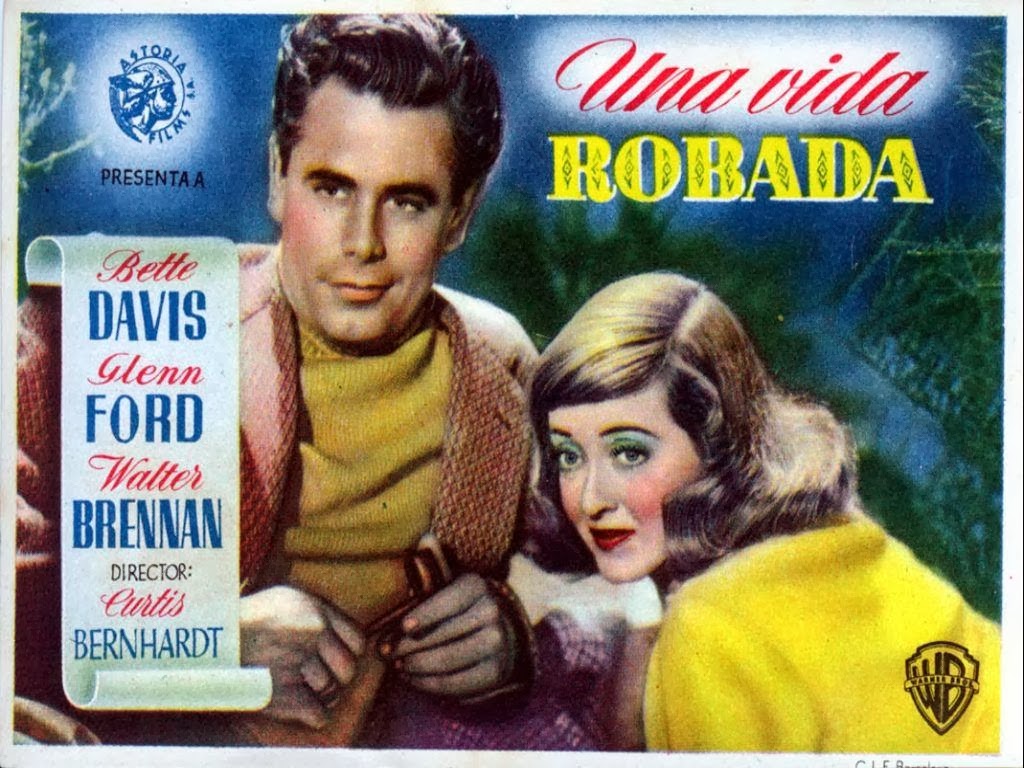We were all VERY impressed with Bette Davis in this dual role. She plays the two characters so that the sisters are subtly different. Patricia is perhaps more the Davis we are used to in films like Jezebel and The Letter - assertive, domineering, in-charge; Kate is more retiring and inward, more like the character Davis played in Now Voyager. It's easy to tell the sisters apart when they are separated, but Davis is able to make them different as they converse with one another. She never seems to lose focus of who she is portraying. And while the costuming by Orry-Kelly gives us slight clues, those differences are also subtle, letting Davis do the work through her acting.
While Glenn Ford is very good as Bill, he does come across as a bit of a twit. It's clear that his attraction to Patricia is purely sexual. He states that he likes Kate, but that there was never a spark between them like there is between him and Pat. Yet, it's clear that Pat is his total opposite - where he is unambitious and wants a simple, country life, she is all about the city and excitement. Why Pat would want to do more than have a brief fling with him is a big question here. It's clear that she is gone off with her sister's beaus before. Does she want to marry Bill only because it is clear that Kate is finally in love? One wonders if Pat is interested in keeping her sister uninvolved (and therefore, closer to her) than in stealing her sister's great love. By marrying Bill, we know that Kate will never involved herself with him again leaving the sisters' relationship status quo.
The only character that is wasted in the film is Dane Clark as the artist Karnock. At first, it seems he might be the person who will make Kate forget Bill, but he is so eminently disagreeable, that it's hard to warm to him. Only in one scene, where he encounters Kate posing as Pat, are we allowed to find him even the slightest bit likeable. Unfortunately, the character never goes anywhere, and we were left wondering what the film would have been like if he had actually become involved with Pat.
On the other hand, Charles Ruggles gives a well-rounded performance as Kate and Pat's guardian, Freddie Linley. Though he says very little, his understanding of the sisters is obvious. He affection for Kate is also apparent. In the end, we discover he really is the only one who truly "knows" them. A quick nod also to Walter Brennan doing what he does best - being irascible; no one really does it better!
Bette Davis was a producer on the film, as is discussed in this TCM Article, and she had say in the casting. Dennis Morgan was originally considered for the part of Bill, but Davis would not have him in the part. The studio then suggested Robert Alda, and while she accepted Alda, she really wanted Glenn Ford. However, Jack Warner didn't want to pay the money for a loan-out from Columbia, until Davis was able to show him a screen test of Ford in the part. The film is actually a remake of a 1939 German film, starring Elisabeth Bergner (perhaps best known in the US for her role as Rosalind in the 1936 As You Like It).
Though A Stolen Life was not really admired by The New York TImes when it was released, we think it is a movie that has aged remarkably well. In this age of digital special effects, you will be amazed at what was possible in a 1940's film. You will totally believe that the twins are talking with one another. To give you a taste of what's in store, here is Bette talking to Bette:



I agree with you about Glenn Ford's character. It's obvious which sister is the more logical choice (perhaps he suffers from Bad Girl Syndrome). As you wrote, Bette is very good in both roles. I also like the Hollywood-stylized setting. It would be interesting to contrast this film with Bette's later DEAD RINGER.
ReplyDeleteWe will have to look into "Dead Ringer" at a later date! It would be interesting. We've done point/counterpoint before (specifically on "Craig's Wife"/"Harriet Craig" and on the two versions of "So Big". While not the same film by any means, the idea of the same actress playing twins in two different films is intriguing.
ReplyDelete